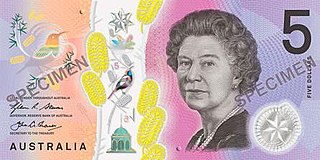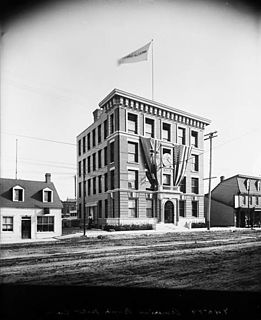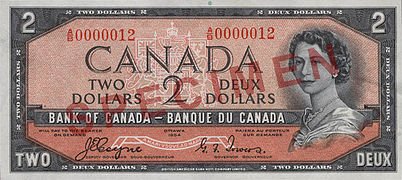
Engraving is the practice of incising a design onto a hard, usually flat surface by cutting grooves into it with a burin. The result may be a decorated object in itself, as when silver, gold, steel, or glass are engraved, or may provide an intaglio printing plate, of copper or another metal, for printing images on paper as prints or illustrations; these images are also called "engravings". Engraving is one of the oldest and most important techniques in printmaking. Wood engraving is a form of relief printing and is not covered in this article.

The United States five-dollar bill ($5) is a denomination of United States currency. The current $5 bill features the 16th U.S. President (1861-65), Abraham Lincoln's portrait on the front and the Lincoln Memorial on the back. All $5 bills issued today are Federal Reserve Notes.

The United States one hundred-dollar bill ($100) is a denomination of United States currency. The first United States Note with this value was issued in 1862 and the Federal Reserve Note version was launched in 1914, alongside other denominations. Statesman, inventor, diplomat, and American founding father Benjamin Franklin has been featured on the obverse of the bill since 1914. On the reverse of the banknote is an image of Independence Hall in Philadelphia, which has been used since 1928. The $100 bill is the largest denomination that has been printed and circulated since July 13, 1969, when the denominations of $500, $1,000, $5,000, and $10,000 were retired. The Bureau of Engraving and Printing says the average life of a $100 bill in circulation is 90 months before it is replaced due to wear and tear.

National Bank Notes were United States currency banknotes issued by National banks chartered by the United States Government. The notes were usually backed by United States bonds the bank deposited with the United States Treasury. In addition, banks were required to maintain a redemption fund amounting to five percent of any outstanding note balance, in gold or "lawful money".

Intaglio is the family of printing and printmaking techniques in which the image is incised into a surface and the incised line or sunken area holds the ink. It is the direct opposite of a relief print.

The Confederate States dollar was first issued just before the outbreak of the American Civil War by the newly formed Confederacy. It was not backed by hard assets, but simply by a promise to pay the bearer after the war, on the prospect of Southern victory and independence.

The Australian five-dollar note was first issued on 29 May 1967, fifteen months after the currency was changed from the Australian pound to the Australian dollar on 14 February 1966. It was a new denomination with mauve colouration – the pound system had no £2½ note.

ABCorp is an American corporation providing secure payment, retail and ID cards, vital record and transaction documents, systems and services to governments and financial institutions - and is one of the largest producers of plastic transaction cards in the world. ABCorp has offices and manufacturing facilities in the United States, Canada, Australia, New Zealand, China, Germany, Dubai and South Africa. Formerly known as the American Bank Note Company, the organization was originally a major worldwide engraver of national currency and postage stamps.
This page is a glossary of notaphily. Notaphily is the study of paper money or banknotes.

The 1935 Series was the first series of banknotes of the Canadian dollar issued by the Bank of Canada. They were first circulated on 11 March 1935, the same day that the Bank of Canada officially started operating. Two sets of banknotes were printed for each denomination, one in French for Quebec, and one in English for the rest of Canada. This is the only series issued by the Bank of Canada with dual unilingual banknotes.
The 1937 Series was the second series of banknotes of the Canadian dollar issued by the Bank of Canada. The banknotes were issued into circulation on 19 July 1937, at which time the Bank of Canada began gradually removing banknotes from the 1935 Series from circulation. The $1000 banknote was issued several years later, as it was primarily used by chartered banks, which had a sufficient supply of the 1935 Series $1000 banknote.
Scenes of Canada was the fourth series of banknotes of the Canadian dollar issued by the Bank of Canada. It was first circulated in 1970 to succeed the 1954 Series, and was replaced by the Birds of Canada series beginning in 1986.

The Canadian Journey series is the sixth series of banknotes of the Canadian dollar designed and circulated by the Bank of Canada. It succeeded the Birds of Canada banknote series. The first of the banknotes issued into circulation was the $10 banknote on 17 January 2001, and the last to be issued was the $50 banknote on 17 November 2004. The series was succeeded by the Frontier Series, banknotes of which were first issued into circulation from 2011 to 2013.
This article concerns the banknotes of the New Zealand dollar

Birds of Canada are banknotes of the Canadian dollar first circulated by the Bank of Canada in 1986 to replace the Scenes of Canada series. Each note features a bird indigenous to Canada in its design. The banknotes weigh 1 gram with dimensions of 152.40 by 69.85 millimetres. It was succeeded by the Canadian Journey Series introduced in 2001.

In celebration of the total solar eclipse of August 11, 1999, the National Bank of Romania (BNR) decided to issue a commemorative two thousand Romanian lei banknote. This was the last solar eclipse of the millennium and was visible across southern Romania. Since it was the last eclipse of the millennium, the denomination was chosen to be 2000 in respect to the upcoming year. These notes were issued as legal tender.

The Frontier Series is the seventh series of banknotes of the Canadian dollar released by the Bank of Canada. The polymer banknotes were designed to increase durability and to incorporate more security features over the preceding Canadian Journey Series. The notes feature images that focus on historic Canadian achievements and innovation. It is the first banknote series issued by the Bank of Canada printed on a material other than paper.
In early 18th century Colonial America, engravers began experimenting with copper plates as an alternative medium to wood. Applied to the production of paper currency, copper-plate engraving allowed for greater detail and production during printing. It was the transition to steel engraving that enabled banknote design and printing to rapidly advance in the United States during the 19th century.
Siderography is a mechanical process developed by Jacob Perkins in the early 1800s enabling the unlimited reproduction of engraved steel plates. The process enables the transfer of an impression from a steel plate to a steel cylinder in a rolling press. An individual who engraves steel plates was known as a siderographist in the mid 1800s, and a siderographer by the early 1900s.
Four banknotes of the Canadian dollar have been commemorative issues. The first was issued in 1935 to the silver jubilee of the accession of George V to the throne of the United Kingdom, the only $25 banknote ever issued by the Bank of Canada. The second commemorative banknote was the Centennial $1 banknote issued in January 1967 to commemorate the Canadian Centennial. The third was issued in September 2015 to commemorate Elizabeth II becoming the longest-reigning monarch of the United Kingdom and Canada. In 2017, the Bank of Canada released a commemorative $10 banknote for Canada's sesquicentennial, which was available by Canada Day.
































